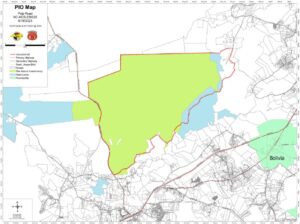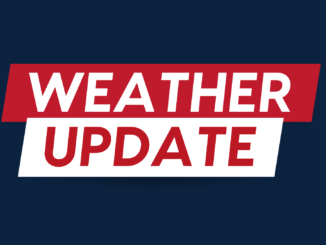
As the 16,000 acre fire in the Green Swamp Preserve moves into its fifth day, crews are gaining on the blaze.
The fire started as a 400 acre controlled burn last week, according to the N.C. Forest Service. The Nature Conservancy and the Wildlife Resources Commission conduct regular burns in the preserve to improve habitat and reduce fire hazards. The Conservancy applied for a burn permit June 13, and lit the fire the same day.
“Commission staff continued to monitor the burn site and conducted mop-up operations as needed,” WRC Spokesperson Fairly Mahlum said in a press release. The mop-up including knocking down small fires nearer the perimeter of the burn. Staff continued monitoring the site June 14.
On June 15, the stubborn fire was pushing the limits and showing no signs of slowing down.
“While on another visit to survey the burn site,” the press release said, “Commission staff discovered some of the burn site reignited. Due to complex terrain within the swamp and difficulty of accessing heavily forested and overgrown areas, Commission staff called the North Carolina Forest Service to assist with supplemental equipment.”
The Forest Service took command of the fire response Friday.

The fire is currently just under twice the size of Lake Waccamaw. It stretches from close to the Columbus County line down Pulp Road and back out to N.C. 211. The initial burn area was significantly smaller, and closer to the interior of the Preserve.
WRC officials on Sunday responded to social media criticism about timing of the fire. Sportsmen and wildlife watchers descried setting the fire in mid-June, when many species of birds and mammals, including turkey, deer, rabbits and endangered woodpeckers are nesting.
“Commission wildlife foresters, technicians and biologists conduct the majority of prescribed fires, also called controlled burns, between January and March when trees are less active metabolically,” Mahlum wrote. “But they continue some fires into spring and summer because warm season burning provides for better control of young hardwoods, which will re-sprout from the base if repeated fires are not conducted.
Prescribed burns encourage production of native grasses and herbaceous vegetation, which provides valuable food and cover for a variety of wildlife, Mahlum wrote.
“Animals like deer browse on groundcover. Quail and songbirds utilize seed produced by native plants. Quail as well as other species, such as turkeys and rabbits, use the groundcover for nesting. In fact, many of North Carolina’s declining or rare wildlife species are adapted to and found only in fire-dependent habitat, which underscores the need for the Commission to continue its prescribed fires program across the state.”
Red-cockaded woodpeckers, Bachman’s sparrows, golden-winged warblers, painted buntings, timber rattlesnakes, northern pine snakes and gopher frogs are just a few animals that benefit from the habitat created from a prescribed fire, she said. Each of these animals is listed as an endangered or threatened species or a species of special concern in North Carolina because of declining populations.
NCFS Operations Section Chief Kenny Griffin said in a video briefing Monday (today) that the fire suppression efforts including strategically set fires that allowed avenues of escape for wildlife.
“It’s not like it’s all burned,” he said, gesturing to a map of the fire zone.
To prevent the fire from spreading outside of the preserve, Griffin explained that NCFS personnel used drones and helicopters to precision drop “ping pong balls” that ignite and start small fires. The smaller fires were lit along lines ahead of the main blaze, and will eventually deprive the fire of fuel. Those small fires move toward the main blaze, he explained. This allowing corridors for wildlife to get to safety.
The use of the incendiaries also ensures that there will be pockets of green scattered throughout the forest. Officials said the forest will rapidly recover from the burn, with new growth from dormant plants and seeds appearing within weeks.
Confining the fire between existing roads and allowing the decades of storm debris to burn is the safest long and short term alternative, he explained. The nature of the peat-rich ground makes operating tractors and bulldozers dangerous. Heavy equipment also leaves a permanent impact on the land, where the controlled burns will help rejuvenate the soil.
Some areas that are burning have not seen fire since the 1950s, when a major wildfire swept from the Brunswick County line past Bolton. Decades of hurricanes, tropical systems, tornadoes and ice storms have left large amounts of debris on the forest floor, making entry difficult for personnel on foot or vehicle.
The forest litter creates hazardous fire conditions by providing quick-burning pine wood, pine straw and pine resin. The same debris breaks down to become the flammable organic soil that can sometimes burn for months underground.
The fire was considered 10 percent contained as of this morning’s briefing. More than 80 personnel are working the fire as of today. Air units, heavy equipment and firefighters on foot are monitoring the blaze.
N.C. 211 is closed from Camp Branch to Little Macedonia on the Brunswick County side of the line. Heavy equipment and emergency vehicles are maintaining N.C. 211 as the south and western borders of the fire.
While the onshore breezes and fire crews have kept the fire itself from spreading further east and south, smoke continues to be a problem in the area, especially in Brunswick County, where a Code Red Air Quality alert was issued. The Code Red designation means the outside air is unhealthy for anyone to breathe for an extended period of time. The nature of the fire means there is excessive particulate matter in the smoke. Ashes have been reported falling in Lake Waccamaw, Buckhead and Bolton in Columbus, as well as throughout Brunswick and New Hanover counties.
Columbus and Bladen are under a Code Orange alert, which means people with health problems, the elderly and children could be affected.
Relief may be on the way as early as tonight.
An unstable weather system is drawing moisture from the Gulf of Mexico along the North Carolina coast this week. The system is expected to bring several inches of rain to the area through Saturday.






















